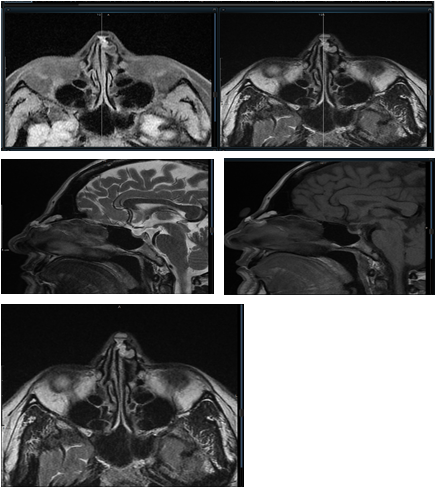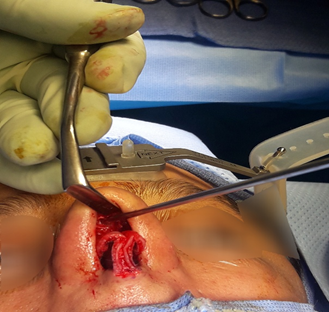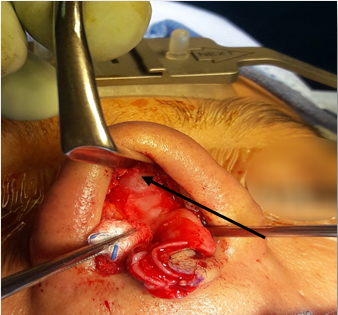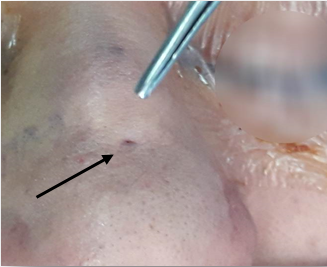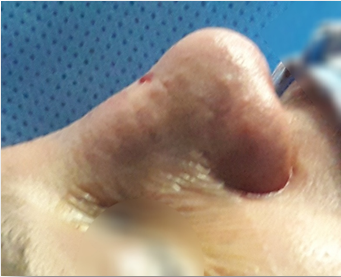Case Report
Volume 2 Issue 1 - 2020
Our Experience with Nasal Dermoid in 41 years old Female (Case Report)
Departments of Otolaryngology/Head & Neck Surgery, Tawam Hospital, United Arab Emirates.
*Corresponding Author: AlQaydi Maryam Ali, Departments of Otolaryngology/Head & Neck Surgery, Tawam Hospital, United Arab Emirates.
Received: March 26, 2020; Published: April 08, 2020
Introduction
Nasal dermoid is an uncommon midline anomaly. Its incidence has been reported to be 1 out of 20.000 live births [1]. The incidence of nasal dermoid more in males than females. 10% of dermoid cysts found in the head & neck. [2] Most of dermoids are diagnosed with in the first 3 years of life but in some cases the diagnosis can be delay. [3] Complete excision of nasal dermoid is mandatory in order to prevent recurrence. Multiple approaches have been described, including vertical incision, transverse incision, lateral rhinotomy, medial paracanthal, Ushaped dorsal incision, external rhinoplasty, degloving procedure, transglabellar incision, brow incision, bicoronal incision and endoscopic. [4] We discuss in this article our experience with patient with nasal dermoid.
Case Report
A 41 years old female, presented to our clinic (otolaryngology head & neck surgery) in our institute (Tawam hospital, United Arab Emirates), with a chief complaint of painless mass on nasal dorsum from 3 months, which increased in size gradually. No other relevant history. On examination: Mass at nasal dorsum on bony nose, soft non tender 1*1 cm non pulsatile and non-compressible mass. There was skin pit over the dorsum of nose. No history of discharge from this pit. Fiberoptic scope examination was done, and it was normal, no mass intranasal. CT scan of paranasal sinus was done showed soft tissue lesion 24.75*16.43 mm at the dorsum of nose with extension into nasal cavity and termination in the midline of anterior superior ethmoid sinus and well-defined elongated defect in the nasal bone. There is a bone defect measures about 2*1 cm. (Figure 1, 2 and 3) MRI scan was done, no intracranial extension .and the diagnosis was nasal dermoid. Figure 4, 5, 6, 7 and 8
The patient was taken for surgical excision of the mass under general anesthesia. Patient underwent open septorhinplasty and functional endoscopic sinus surgery with navigation system to achieve complete excision of dermoid cyst and good cosmetic results. So external rhinoplasty approach was done started by inverted V columella incision. Then identification of the lower& upper lateral cartilages was done. Figure 9 the dermoid cyst (involve the lower 2/3 of the nasal bone in the midline) was identified. Figure 10 The cyst attached by tract to the skin of the nose forming a skin pit. figure 1
Excision of the external cutaneous pit and complete excision of the dermoid cyst was done. The mass was sent for histopathology examination. The area of the dermoid cyst was checked by endoscope to ensure no cyst remnant. Curettage of the dermoid cyst area was done. Then medial osteotomies and excision of the cartilaginous hump & the upper part of the nasal septum was done. Intradomal & transdomal suturing was performed. Columella strut was inserted. Dorsal cartilage graft to replace the bony defect was inserted also. The operation was ended by inserting Naspore nasal packs, Steristrip and external splint. Figure 12.
The histological examination revealed diagnosis of dermoid cyst and there is fragments of cartilage and bone tissue. The patient continues to attend her regular follow-ups in our clinic (3 months figure 13 and 6 months figure 14) without any recurrence with good cosmetic shape of nose.
Discussion
Nasal dermoid is congenital midline nasal mass. [1] Nasal dermoid can be located in the fronto-temporal region, orbital region, or most commonly the nasoglabellar region. It is firm, non-compressible, non-pulsatile masses & do not transilluminate. Dermoid sinus cysts of the nose present as a midline nasal pit, fistula or infected mass. Up to 50% of the nasal dermoid have a fistula or sinus tract. [2] Associated congenital anomalies in 5-41% of cases which including hypertelorism, cleft lip and palate, aural atresia, hydrocephalus, hemifacial microsomia, branchial sinuses albinism, cardiac, gastrointestinal, genital and central nervous system anomalies. [2,3] Early surgery for avoiding distortion of the nose or bony atrophy. if there is suspicion of nasal dermoid, biopsy is contraindicated because can cause CSF leakage. The diagnosis of nasal dermoid cysts is usually made by typical clinical symptoms and radiologic finding. Workup should include fine – cut CT and complementary MRI should be considered to check the of lesion and intracranial extension [2]. Intracranial extension of nasal dermoid was reported in 10% - 45% of cases. [5] There are two factors determine the surgical approach intracranial extensions and lesions extension. Surgical approaches including transverse rhinotomy, sept rhinoplasty approach, vertical rhinotomy, horizontal nasofrontal incision with eyebrow extensions and endoscopic approach. [6] The recurrent rate has been reported in 50% to 100% of cases, after incomplete excision of dermoid. [5]
Conclusion
Nasal Dermoid cyst is rare congenital lesion. We present an unusual case of an adult patient with dermoid cyst without intracranial externsion or other associated congenital anomalies. Which was successfully removed via the open septorhinplasty and functional endoscopic sinus surgery approach.
References
- Mahmoud Fawzy ElBestar and Lubna Fawaz. (2008). Nasal Dermoid: A Segmental Approach. Annals of Pediatric Surgery, Vol 4, No 3 & 4 July-October, PP 100-1060.
- Van Wyhe., et al. (2016). Midline Craniofacial Masses in Children. Seminars in Plastic Surgery. Vol. 30 No. 4.
- Yashwant Maru and Yamini Gupta. (2014). Our experiences with congenital midline nasal dermoid sinus cyst. Clinical Rhinology: An International Journal. January – April 7(1): 43-46.
- Devon M. Livingstone. (2018). Endoscope-assisted nasal dermoid excision with an open rhinoplasty approach. International Journal of Pediatric Otorhinolaryngology Volume 109, Pages 101-103
- Dong Hoon Lee and Tae Mi Yoon. (2018). Dermoid cyst of nasal septum in an adult patient (A case report). Medicine 97: 45.
- Heather Herrington and Eelam Adil. (2016). Update on Current Evaluation and Management of Pediatric Nasal Dermoid. Laryngoscope. 126: 2151–2160.
Citation: AlQaydi Maryam Ali. (2020). Our Experience with Nasal Dermoid in 41 years old Female (Case Report). Journal of Otolaryngology - Head and Neck Diseases 2(1). DOI: 10.5281/zenodo.3755557
Copyright: © 2020 AlQaydi Maryam Ali. This is an open-access article distributed under the terms of the Creative Commons Attribution License, which permits unrestricted use, distribution, and reproduction in any medium, provided the original author and source are credited.


